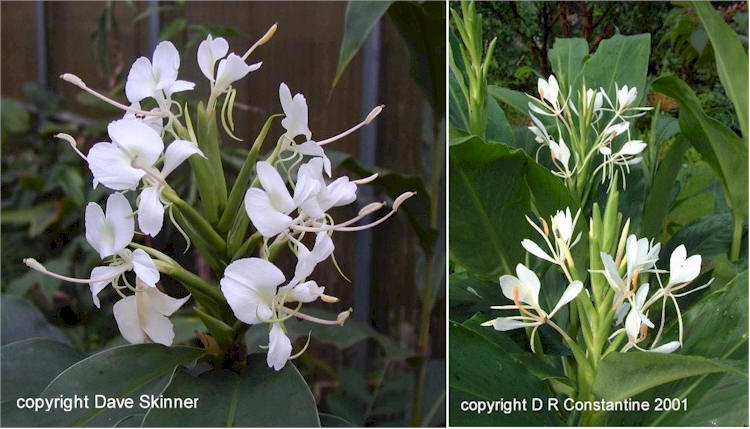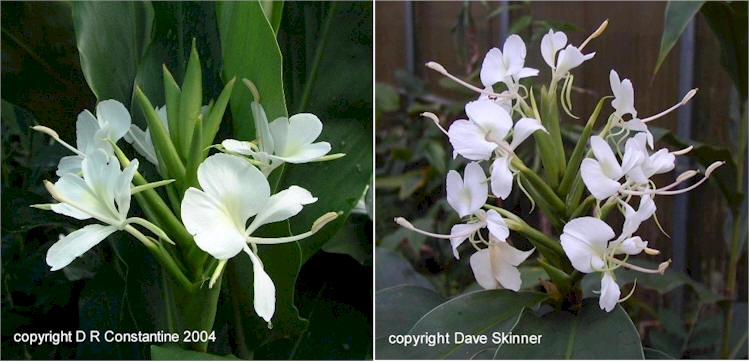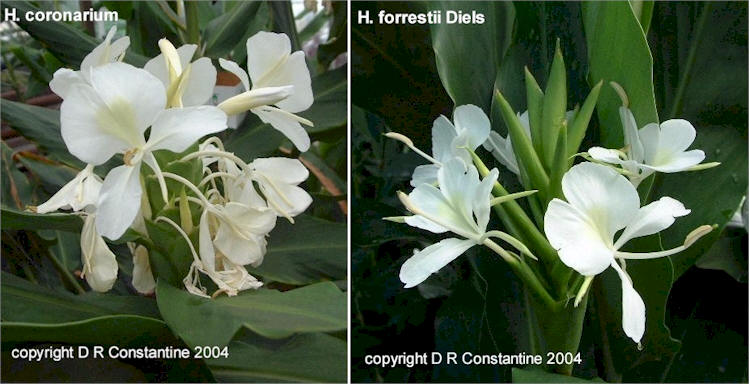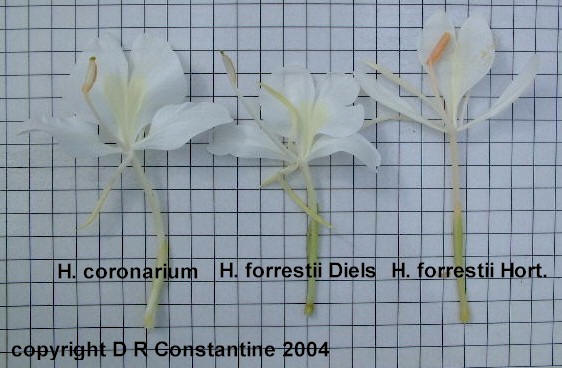.
Hedychium forrestii Diels cf Hedychium forrestii Hort. images
Hedychium forrestii Diels det Tom Wood
The left hand image shows Hedychium forrestii Diels growing at Tom Wood's nursery. The photograph is copyright Dave Skinner and used
here with permission. See Dave Skinner's website for more images.
The right hand image shows Hedychium forrestii Hort. in a Somerset garden.

These photographs are not to the same scale but the differences between the two plants are quite clear. In Hedychium forrestii Diels the whole flower is more or less pure white whereas the stamens of Hedychium forrestii Hort. have conspicuously yellow anthers. The relative length of the stamen and labellum, the shape of the labellum and lateral staminodes are also clearly different in each plant. These differences are surely sufficient to separate two species.
I believe that Hedychium forrestii Hort. derives from material collected by Joseph Rock. To quote from Tony Schilling’s 1982 article on Hedychium in the first series of The Plantsman, “all plants [of Hedychium forrestii] in Britain would seem to have originated from plants sent to the Royal Botanic Garden, Edinburgh by Dr J F Rock in 1957 from ‘P.O. Box 497 Honolulu’. The plants were incorrectly labelled Hedychium gardnerianum. Unless Rock’s field notes can throw further light on the subject of origin the story of the introduction must stop here.” And so it does.
I cannot confirm that my material of Hedychium forrestii Hort. derives from Rock's sending but I have seen a plant that does and it is the same as my material. Because of Rock’s collecting activities it is reasonable to guess that Hedychium forrestii Hort. originated in China but the plant does not key out in the Flora of China and its identity remains a mystery. Hedychium forrestii Hort. comes true from seed so we presume it to be a species but the possibility that it is a hybrid cannot be discounted.
I have material from India (UK 2 courtesy of Ganesh Mani Pradhan) that has been identified as Hedychium forrestii Diels by Tom Wood (see below). With a pressed flower of this plant and Hedychium forrestii Hort. for comparison I examined herbarium material of Hedychium forrestii at RBG Kew and the British Museum. I found it very difficult to draw conclusions from herbarium sheets in which the flowers are generally very poorly displayed. On only one sheet, Kingdon Ward 17960 in BM, was a flower clearly displayed; this closely resembled our Indian material but differed from Hedychium forrestii Hort. This would seem to confirm that the Indian material is Hedychium forrestii Diels but unfortunately Kingdon Ward 17960 is annotated "flowers vermillion" which casts some doubt. Similarly, the illustration of Hedychium forrestii Diels in the Flora of China (here) shows a plant different both from Hedychium forrestii Diels as determined by Tom Wood and from our Hedychium forrestii Hort. I make the crucial assumption that, as the monographer of the genus Hedychium, Mr Wood is correct in his determination of Hedychium forrestii Diels.
Hedychium UK 2 from Ganesh Mani Pradhan - probably Hedychium forrestii Diels
The left hand image shows Hedychium UK 2 from Ganesh Mani Pradhan growing in the UK.
The right hand image shows Hedychium forrestii Diels growing at Tom Wood's nursery. The photograph is copyright Dave Skinner and used
here with permission. See Dave Skinner's website for more images.

Ganesh Mani Pradhan kindly sent material of an unnamed Hedychium designated UK 2. This flowered in the UK under glass. The plant appears very similar
to Hedychium forrestii Diels as determined by Tom Wood.
UK 2 resembles Hedychium coronarium but there are several differences.
The first difference is that the bracts of Hedychium coronarium are imbricate whereas those of Hedychium forrestii Diels are rolled - see photo below

The second difference is that the flowers of Hedychium coronarium are larger than Hedychium forrestii Diels - see photo below
cm grid

The third difference is that the flowers of Hedychium forrestii Diels, while fragrant, lack the heavy gardenia-like fragrance of Hedychium coronarium.
back to Hedychium forrestii Diels
back to Hedychium forrestii Hort.